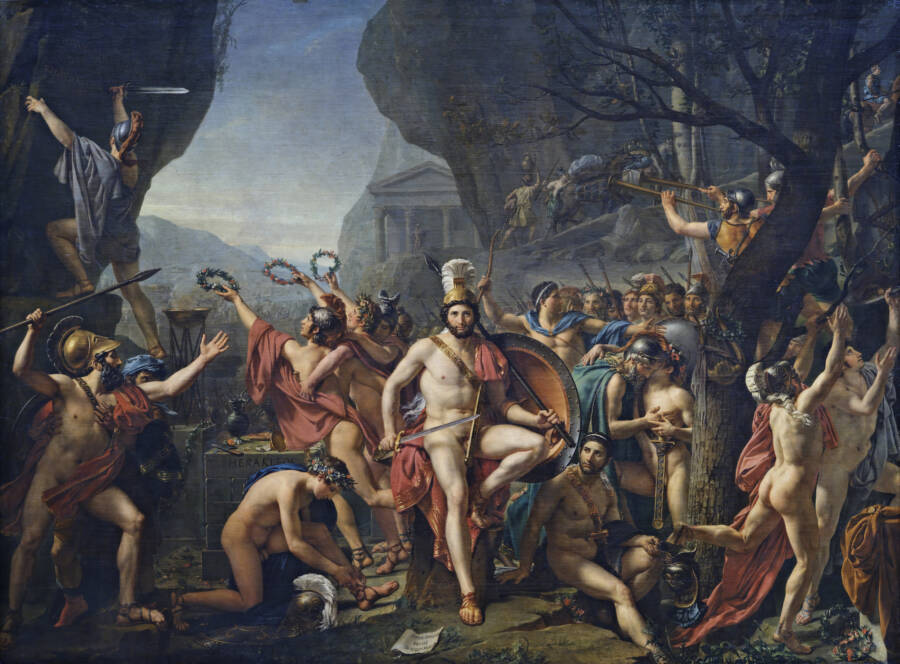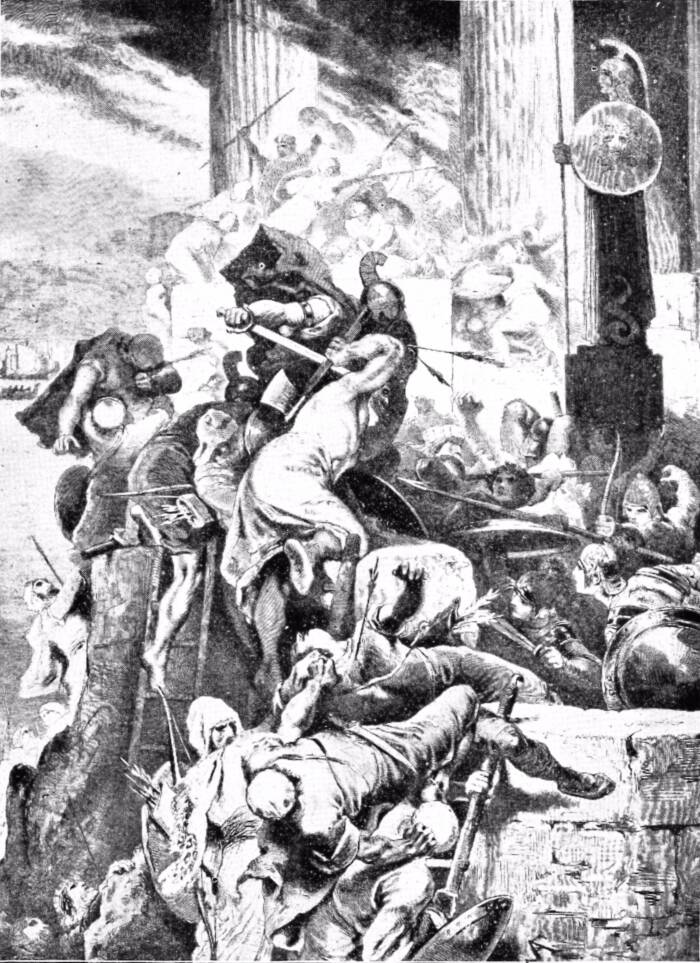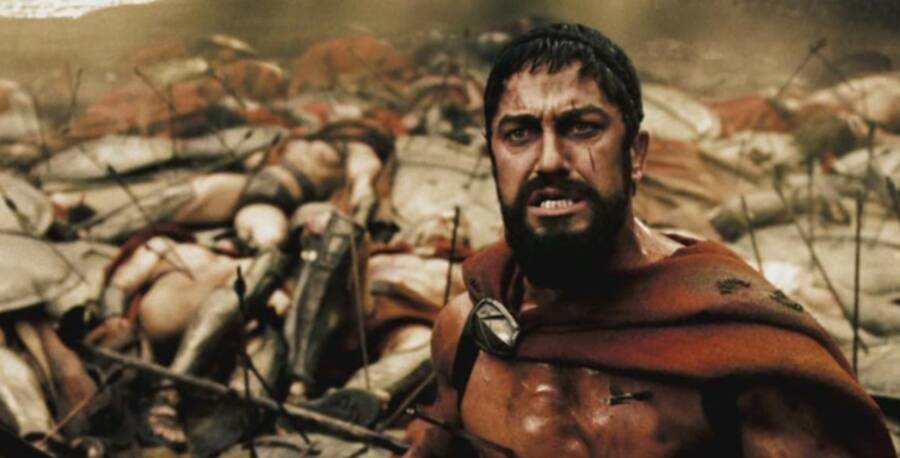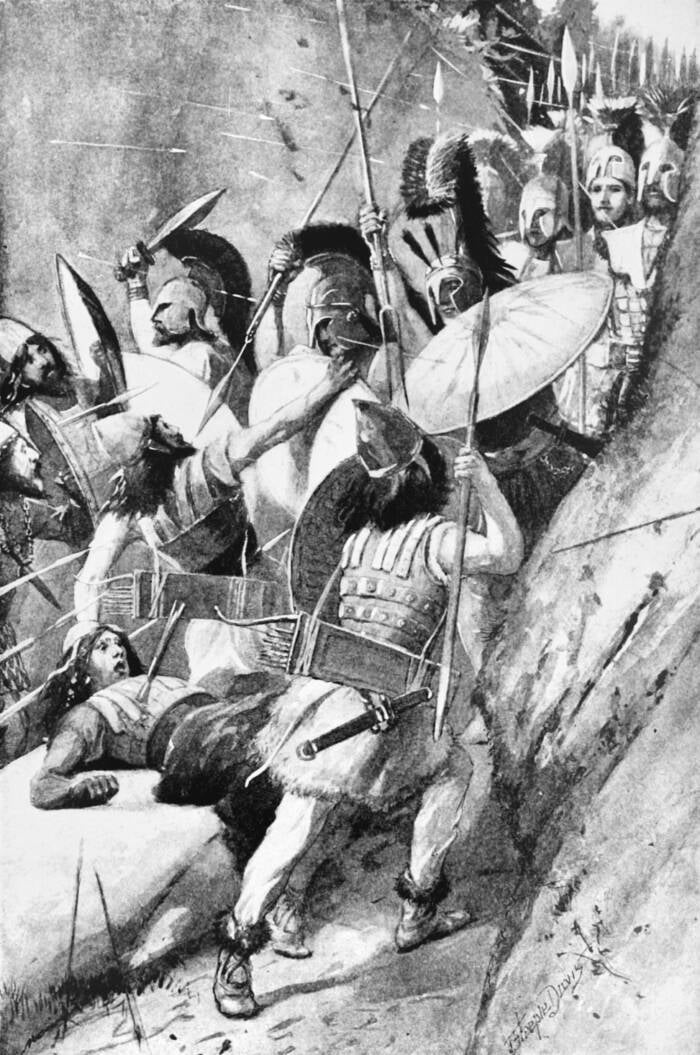In 480 B.C.E., King Leonidas of Sparta led 7,000 Greek troops against as many as 300,000 Persian soldiers at the Battle of Thermopylae — and the Greeks may have won if they hadn't been betrayed.

Public DomainKing Leonidas and the Greek army at the Battle of Thermopylae.
Zack Snyder’s 2006 film 300 was a major box office success and a cultural touchstone, largely thanks to the film’s iconic line, “This is Sparta!” While the real King Leonidas never shouted those words — and certainly not in English — the story of how 300 Spartan soldiers held off the invading Persian army of Xerxes I at the Battle of Thermopylae was at least somewhat grounded in fact.
In 480 B.C.E., Xerxes I’s army advanced southward through the mountain pass at Thermopylae. In a way, it was his mission to atone for the failure of his predecessor, Darius I, who had previously attempted an invasion of Greece only to be met with defeat at the Battle of Marathon. A decade later and with a sizable army of his own, Xerxes was determined to find success where Darius had failed.
While Xerxes’ men were ultimately the ones who won the Battle of Thermopylae, the Greeks didn’t submit easily. They managed to hold the Persian army off for three days until they were betrayed and outflanked. Then, King Leonidas of Sparta, who led the Greek forces, ordered the main army to retreat while he remained behind with 300 Spartans and a couple thousand allies.
Although Leonidas and his men were killed, their sacrifice at the Battle of Thermopylae cemented their heroic legacy that endures to this day.
The Persian Defeat At The Battle Of Marathon

Public DomainThe Battle of Marathon marked a major defeat for the Persians under Darius I.
A decade before the Battle of Thermopylae, King Darius I was dealing with a revolt in Ionia. The Athenians, seeing trouble on the horizon, lent aid to Ionia and inadvertently incurred the wrath of Darius.
Once the revolt had been squashed, Darius then refocused his attention on Greece. His army moved swiftly to capture Eretria, then set sail for Marathon, where they were met by a much smaller Greek force. Darius I’s troops quickly learned that while there may have been strength in numbers, it wasn’t as much as they had assumed.
Just five days later, the Battle of Marathon ended with a Greek victory and Darius in need of a new army. He spent the better part of the next 10 years rebuilding and preparing for another invasion — only to die before he got his chance.
His son Xerxes, however, was more than willing to take up the mantle.
After succeeding to the throne of Persia in 486 B.C.E., Xerxes continued to make extensive preparations for the invasion of mainland Greece. Then, in the summer of 480 B.C.E., he made his move.
The Lead-Up To The Battle Of Thermopylae

Public DomainPersians capturing the Greek Acropolis under Xerxes I.
Xerxes, like his father Darius, had been dealing with a small revolt in the lead-up to his invasion. His was in Egypt, and his troops snuffed it out quickly, all the while preparing for a full-scale invasion of Greece.
He ordered the construction of bridges and canals to make access to the Greek mainland easier, looking to avoid the strategic missteps that had led to the Persian army’s defeat under his father’s rule. The preparations were complete by 480 B.C.E., and soon his force — of anywhere between 100,000 and 300,000, according to varying historical reports — was set for the invasion.
Athens had been making preparations for war as well. Unfortunately, they quickly realized they lacked the manpower to hold off Xerxes’ army, and so they requested the help of other Greek city-states.
“After [Xerxes] arrived in Sardis, he first sent heralds to Hellas to demand earth and water and to command the preparation of meals for the king,” the historian Herodotus wrote in The Histories. “He sent demands for earth everywhere except to Athens and Lacedaemon [Sparta]. The reason for his sending for earth and water the second time was this: he fully believed that whoever had not previously given it to Darius’ messengers would now be compelled to give by fear.”

Fkerasar/Wikimedia CommonsThe site of the Battle of Thermopylae today.
Support for Athens and Sparta started to grow, and shortly before Xerxes’ invasion, in 481 B.C.E., a confederate alliance of Greek city-states was formed — a particularly notable achievement given that many of them were still technically at war with one another. In the face of the looming Persian threat, however, they put aside their own conflicts.
Meanwhile, the Persian army was marching closer and closer. In the summer of 480 B.C.E., a Greek spy reported that the Persian army was fast approaching — and war was imminent.
How A Small Greek Army Withstood The Might Of The Persians

Warner Bros. PicturesWhile the movie 300 portrays the Battle of Thermopylae, much of the plot is fictionalized, such as the Persians’ use of war elephants and rhinos during battle.
Xerxes offered Leonidas and the Greek resistance one final chance before invading. After hearing that Leonidas and the Spartans were refusing to submit to him, Xerxes pleaded with the king to lay down his arms. In response, Leonidas purportedly told him, “Come and take them.”
Xerxes obliged.
His army, estimated to be made up of anywhere between 100,000 and 300,000 men, marched forward. The 7,000-man Greek army led by Leonidas met Xerxes’ forces at the narrow mountain pass of Thermopylae as well as at sea in the straits of Artemisium. Despite being outnumbered more than tenfold, the Greek army managed to maintain their position, largely thanks to clever strategizing.
The Greeks constricted the battlefield, holding a short line across the narrow pass so that the Persians could not utilize the full extent of their numbers, and over the course of the first two days of fighting, the Persians suffered heavy losses while the Greek army seemed destined for certain victory.

Public DomainThe Battle of Thermopylae took place in a small pass between a steep hillside and the sea.
That changed, however, when a Greek citizen named Ephialtes betrayed Leonidas. Hoping to receive a reward, Ephialtes met with Xerxes and informed the Persian leader of an alternate path that would lead his army around Thermopylae rather than through it. This allowed the Persians to circumvent the narrow pass altogether — and rendered the Greek army’s strategy ineffective.
Once they had circled around to the other side of the pass, the Persians led a devastating attack on the Greek army. In response, Leonidas was forced to make a desperate call.
The Spartans’ Last Stand: Who Won The Battle Of Thermopylae?
With the tide of battle now shifting in favor of Xerxes’ army, Leonidas called a war council. Retreat, the council determined, was the only viable option — and one that stood in direct opposition to the ethos of the Spartans.
So, Leonidas decided that he would not retreat. He gave the call for the majority of the Greek army to fall back, but he, 300 other Spartans, some helots (Spartan slaves), and around 1,100 Boeotians stood their ground and sought to delay the advancing Persian army as much as they could. Even with a significantly reduced fighting force, historical accounts described a vicious battle.

Konstantinos Tamateas/Wikimedia CommonsA monument commemorating King Leonidas and the bravery of his army.
As Herodotus wrote, “For the Greeks, reckless of their own safety and desperate, since they knew that, as the mountain had been crossed, their destruction was nigh at hand, exerted themselves with the most furious valour against the barbarians.”
But if Leonidas was confident that his men could withstand the might of Xerxes’ army, he was sadly mistaken. It was a slaughter. The Spartans fought hand-to-hand with broken swords and spears, while the Persian cavalry easily mowed them down. When the Persians grew tired of their own losses and the gritty up-close combat, they simply turned to bows and arrows, destroying Leonidas’ forces from a safe distance.
Leonidas fell in the battle as well, but the Spartans’ loss was not in vain. Although Xerxes emerged as the winner of the Battle of Thermopylae, the fight did show that the Persians were not an invincible, unstoppable force. With the right strategy, the Greeks could find victory — and they proved it just a month later when they defeated the Persian fleet in the narrow strait of Salamis.
After reading about who won the Battle of Thermopylae between the Greeks and the Persians, go inside the Battle of the Alamo, the last stand that changed the course of the Texas Revolution. Then, learn how alcohol cost the Austrian army the Battle of Karansebes.





